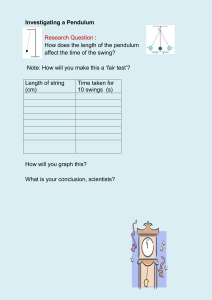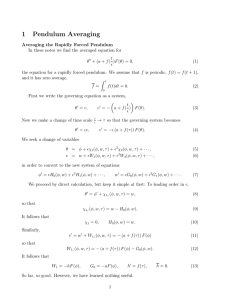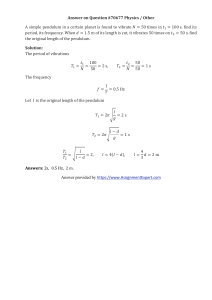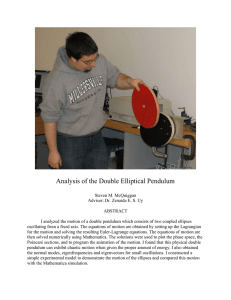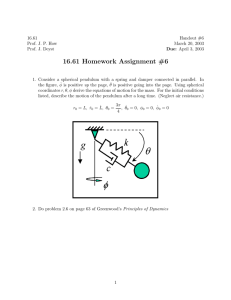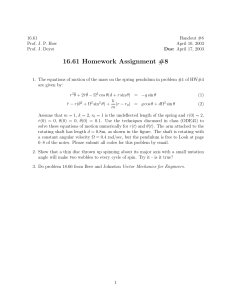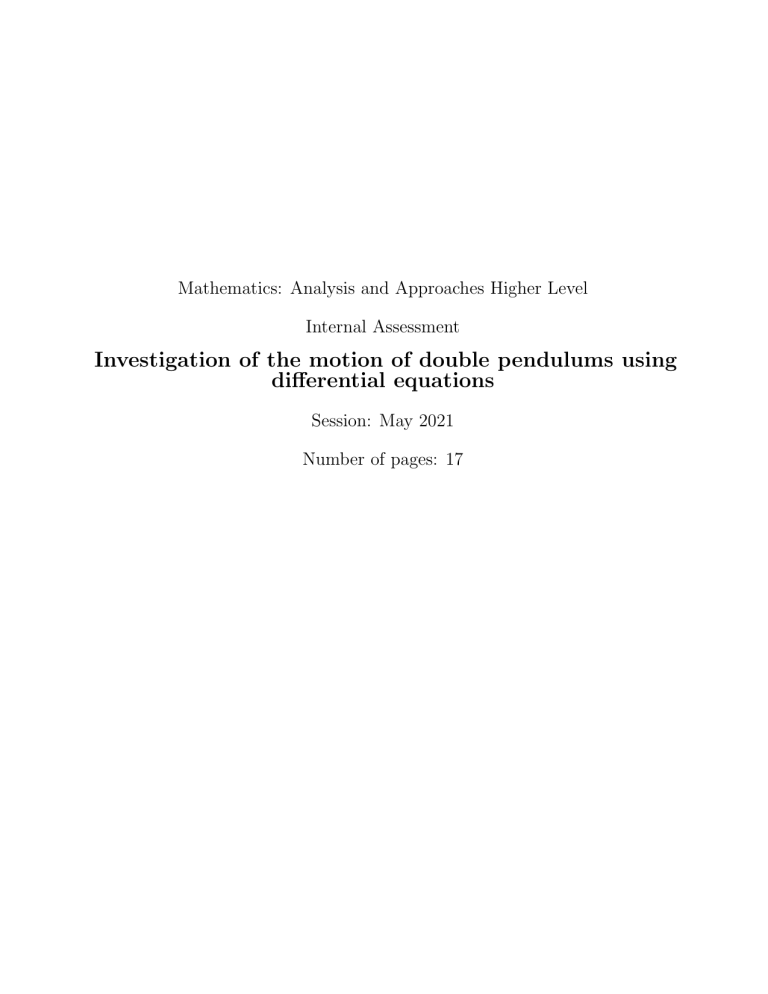
Mathematics: Analysis and Approaches Higher Level Internal Assessment Investigation of the motion of double pendulums using differential equations Session: May 2021 Number of pages: 17 Contents 1 Introduction 1.1 Simple pendulums . . . . . . . . . . . . . . . . . . . . . . . . . . . . . . . . . . . . . 1.2 Double pendulums . . . . . . . . . . . . . . . . . . . . . . . . . . . . . . . . . . . . . 1.3 Aim . . . . . . . . . . . . . . . . . . . . . . . . . . . . . . . . . . . . . . . . . . . . . 1 1 3 3 2 Mathematics used: Lagrangian mechanics and partial differentiation 3 3 The equations of motion 3.1 Description of the system . . . . . . . . . . . . . . . . . . . . . . . . . . . . . . . . . . 3.2 The Euler-Lagrange equations of the system . . . . . . . . . . . . . . . . . . . . . . . 5 5 7 4 Solving the differential equation 4.1 Use of Euler’s Method . . . . . . . . . . . . . . . . . . . . . . . . . . . . . . . . . . . 4.2 Example of solving the DEs using Euler’s Method . . . . . . . . . . . . . . . . . . . . 4.3 Trials . . . . . . . . . . . . . . . . . . . . . . . . . . . . . . . . . . . . . . . . . . . . . 8 8 8 10 5 Results 5.1 Behaviour of standard double pendulum . . . . . 5.2 Behaviour of the double pendulum after tweaks in 5.3 Divergence of trajectories . . . . . . . . . . . . . . 5.4 Trajectory of approximations to simple pendulum 11 11 13 15 16 . . . . . . . . . . initial conditions . . . . . . . . . . . . . . . . . . . . . . . . . . . . . . . . . . . . . . . . . . . . . . . . . . . . . . . . . . . . 6 Potential further study 17 7 Conclusion 17 References A Behaviour of angles in double pendulums A.1 Behaviour of standard double pendulum . . . . A.2 Behaviour after 5% increase in θ10 . . . . . . . . A.3 Behaviour after 5% increase in θ20 . . . . . . . . A.4 Behaviour after small initial ω10 . . . . . . . . . A.5 Behaviour after small initial ω20 . . . . . . . . . A.6 Behaviour after 5% increase in m1 . . . . . . . . A.7 Behaviour after 5% increase in m2 . . . . . . . . A.8 Behaviour after 5% increase in l1 . . . . . . . . A.9 Behaviour after 5% increase in l2 . . . . . . . . A.10 Approximation to single pendulum: small angle A.11 Approximation to double pendulum: large angle i . . . . . . . . . . . . . . . . . . . . . . . . . . . . . . . . . . . . . . . . . . . . . . . . . . . . . . . . . . . . . . . . . . . . . . . . . . . . . . . . . . . . . . . . . . . . . . . . . . . . . . . . . . . . . . . . . . . . . . . . . . . . . . . . . . . . . . . . . . . . . . . . . . . . . . . . . . . . . . . . . . . . . . . . . . . . . . . . . . . . . . . . . . . . . . . . . . . . . . . . . . . . . . . . . . . . . . . . . . . . . . . . . . . . . . . ii ii iii iv v vi vii viii ix x xi xi 1 Introduction 1.1 Simple pendulums One of the most basic examples of periodic motion in mechanics is the simple pendulum under a gravitational field. It is in high school physics textbooks as an everyday example of periodic motion, and in undergraduate beginner physics textbooks as a beginner’s problem. It consists of a point mass on a massless string. g l m Figure 1: A simple pendulum under a gravitational field Its equation of motion has been well-studied and is given below. g θ̈ = − sin θ l (1) One dot on top of the variable symbol denotes one time derivative. This notation will be used throughout this investigation. θ is the angle between the vertical axis and the string, l is the length of the string, and g is the gravitational field strength. At small angles, equation (1) can be changed to another form using the small angle approximation (sin θ ≈ θ) (Kleppner & Kolenkow, 2014): g θ̈ = − θ l (2) d2 y = −ω 2 y dx2 (3) This is a case of the equation below: 1 This is a well-known ODE with an analytic solution. For equation (2), the solution is: θ = A sin (ωt + φ) , ω 2 = g l (4) Where A and φ depend on initial conditions.(Keisler, 2012) If the angle of oscillation is larger, while equation (1) still has an analytic solution, it is quite complex. Most will simply obtain numerical solutions using Euler’s Method. For example, this is the numerical solution for θ0 = 0.75π, l = 1, g = 9.81, and zero initial angular velocity. Figure 2: Numerical solution using Euler’s method with a time-step of 0.0001 As a student who regularly reads materials in both mathematics and physics, I have encountered the simple pendulum, and similar periodic systems, many times. However, a much more fascinating system is the double pendulum. 2 1.2 Double pendulums Double pendulums consist of two rigid massless rods and two point masses. l1 g m1 l2 m2 Figure 3: Double pendulum under gravitational field The motion of double pendulum is often claimed as ”unpredictable”, ”chaotic”, and ”unintuitive”. It is a famous example of the ”butterfly effect” in chaos theory due to the sensitivity of its motion to initial conditions (Levien & Tan, 1993). It is also well-known for being a problem that is rarely solved using Newtonian mechanics. Instead, Lagrangian mechanics (an alternative formulation of mechanics based on energy) is used. Having an interest in mathematical modelling, I decided to attempt simulating the double pendulum using my own knowledge in physics and the mathematical skills taught in IB Mathematics HL. 1.3 Aim In this investigation: I will endeavour to find out about the motion of the double pendulum by deriving the ODEs using Lagrangian mechanics, then using Euler’s method to find numerical solutions of its motion. 2 Mathematics used: Lagrangian mechanics and partial differentiation Lagrangian mechanics is an alternative formulation of mechanics developed by physicist and mathematician Joseph-Louis Lagrange. It is unlike Newtonian mechanics, as it is based on energy calculations, with no need of calculation using vectors. 3 It is based upon the Euler-Lagrange equation (seen below), which is a result from the Principle of Least Action and calculus of variations (the study of the minima and maxima of functionals) (Susskind & Hrabovsky, 2020). It serves as an alternative to F = ma. d ∂L ∂L = dt ∂ q˙j ∂qj (5) It often involves several variables, and has to use partial derivatives, denoted by ∂. This means the differentiation is focused on one variable, and all others are treated as constants. In the equations, qj is a generalised coordinate, and L is the Lagrangian. It is defined below (Morin, 2007): L=T −V T = N X mk vk2 (6) (7) k=1 T is the kinetic energy (which depends on mass m and speed v), and V is the potential energy. The potential energy depends on the existing force. (Morin, 2007) In the case of an object under a gravitational field: V = N X mk gyk (8) k=1 Where y is the height. Its value depends on the reference level (where potential energy is defined as zero) chosen. (Morin, 2007) In the above equations, N is the number of objects in the system, and k is the designation given to each object. To solve for the equations of motion, there will be multiple Euler-Lagrange equations, each based on one coordinate. For example, q1 can be θ1 , so q˙1 will have to be θ˙1 . θ2 will be treated as a constant during differentiation and formulation of the equation. 4 An example of this partial differentiation can be demonstrated by a simple multivariable function: f (θ1 , θ2 ) = θ1 2 + θ1 θ2 + θ2 2 ∂f ∂f = 2θ1 + θ2 , = θ1 + 2θ2 ∂θ1 ∂θ2 d ∂f d ∂f = 2θ˙1 + θ˙2 , = θ˙1 + 2θ˙2 dt ∂θ1 dt ∂θ2 3 The equations of motion 3.1 Description of the system θ1 g l1 m1 θ2 l2 m2 Figure 4: Diagram of double pendulum with all parameters used Refer to figure 4 for definitions of parameters. l1 , l2 , m1 , and m2 are constant. For the frame of reference, the top fixed pivot will be used as the origin. For the equations of motion, θ1 and θ2 will be solved using the Euler-Lagrange equation. x1 , x2 , y1 , and y2 can be found using the below equations: x1 = l1 sin θ1 (9) y1 = −l1 cos θ1 (10) x2 = x1 + l2 sin θ2 (11) y2 = y1 − l2 cos θ2 (12) To list the required Euler-Lagrange equations, the kinetic and potential energies will need to be computed first to assemble the Lagrangian. They are computed below: 5 Kinetic energy For computation of kinetic energy, v 2 must first be expressed in terms of given variables Using Pythagoras’ Theorem (v 2 = ẋ2 + ẏ 2 ) and equation (7): 1 T1 = m1 (x˙1 2 + y˙1 2 ) 2 (13) 1 T2 = m2 (x˙2 2 + y˙2 2 ) 2 (14) Expanding using equations (9) to (12): T1 = m1 2 2 l1 θ̇1 2 1 1 2 2 T2 = m2 [ l1 2 θ˙1 + l2 2 θ˙2 + l1 l2 cos(θ2 − θ1 )θ˙1 θ˙2 ] 2 2 (15) (16) Gravitational potential energies Using equation (8): V1 = m1 gy1 (17) V2 = m2 gy2 (18) V1 = −m1 gl1 cos θ1 (19) V2 = −m2 g(l1 cos θ1 + l2 cos θ2 ) (20) Expanding using equation (10) and (12): The Lagrangian Using the definition of the Lagrangian (equation 6) and the energies derived above: L = T1 + T2 − V1 − V2 1 = m1 ( l1 2 θ̇12 + gl1 cos θ1 ) 2 1 1 2 2 + m2 [ l1 2 θ˙1 + l2 2 θ˙2 + l1 l2 cos(θ2 − θ1 )θ˙1 θ˙2 + gl1 cos θ1 + gl2 cos θ2 ] 2 2 6 (21) 3.2 The Euler-Lagrange equations of the system To get the equation of motion, one can simply use the Euler-Lagrange equation (eq. 5) For this system, we can use two Euler-Lagrange equations, where q1 is θ1 and q2 is θ2 : d ∂L ∂L = dt ∂ θ˙1 ∂θ1 (22) d ∂L ∂L = dt ∂ θ˙2 ∂θ2 (23) Then, finally, we can derive the equations of motion. Differentiating, we get: d ∂L = (m1 + m2 )l1 2 θ¨1 + m2 l1 l2 [θ¨2 cos(θ2 − θ1 ) − θ˙2 (θ˙2 − θ˙1 ) sin(θ2 − θ1 )] dt ∂ θ˙1 ∂L = = m2 l1 l2 θ˙1 θ˙2 sin(θ2 − θ1 ) − (m1 + m2 )gl1 sin θ1 ∂θ1 (24) d ∂L = m2 l2 2 θ¨2 + m2 l1 l2 [θ¨1 cos(θ2 − θ1 ) − θ˙1 (θ˙2 − θ˙1 ) sin(θ2 − θ1 )] ˙ dt ∂ θ2 ∂L = −m2 l2 [l1 sin(θ2 − θ1 )θ˙1 θ˙2 + gsinθ2 ] = ∂θ2 (25) These equations can then be transformed into a form suitable for numerical solving: [1 − m2 m2 2 2 cos2 (θ2 − θ1 )]l1 θ¨1 = −g sin θ1 + sin(θ2 − θ1 )(l2 θ˙2 + l1 cos(θ2 − θ1 )θ˙1 ) m1 + m2 m1 + m2 (26) m2 + g cos(θ2 − θ1 ) sin θ2 m1 + m2 [1 − m2 2 cos2 (θ2 − θ1 )]l2 θ¨2 = −g sin θ2 − sin(θ2 − θ1 )θ˙1 m1 + m2 m2 l2 2 − cos(θ2 − θ1 )[ sin(θ2 − θ1 )θ˙2 − g sin θ1 ] m1 + m2 (27) One method for verifying these equations is to take the limiting case of the single pendulum, which means letting m2 and l2 approach 0. In this case, equation (26) becomes: l1 θ¨1 = −g sin θ1 which is identical to equation (1). 7 4 4.1 Solving the differential equation Use of Euler’s Method To numerically solve for θ1 (t) and θ2 (t), Euler’s method must be used. This is achieved by the equations below: θi (0) = θi0 (initial conditions) dθi = f (θ1 , θ2 ) ωi = θ˙i = dt θi (t + dt) = θi (t) + θ˙i (t) × dt, i = 1, 2 (28) (29) (30) However, θ˙i (t) must also be solved numerically using Euler’s method: θ˙i (0) = ωi0 (initial conditions) d2 θi θ¨i = 2 = f (θ1 , θ2 , θ˙1 , θ˙2 ) dt θ˙i (t + dt) = θ˙i (t) + θ¨i (t) × dt, i = 1, 2 (31) (32) (33) θ¨1 and θ¨2 can be found by using equations (26) and (27). They are used in equation (33) to solve for θ˙1 and θ˙2 , which are then used in equation (30) to find angular displacements. 4.2 Example of solving the DEs using Euler’s Method Conditions: m1 = m2 = l1 = l2 = 1 θ1 (0) = 0.25π, θ2 (0) = 0.5π θ˙1 (0) = θ˙2 (0) = 0 dt = 0.001 8 1 1 cos2 (0.25π)]θ¨1 (0) = −g sin(0.25π) + g cos(0.25π) sin(0.5π) 2 2 √ 2 θ¨1 (0) = − g 3 1 [1 − cos2 (0.25π)]θ¨2 (0) = −g sin(0.5π) − cos(0.25π)[−g sin(0.25π)] 2 2 θ¨2 (0) = − g 3 [1 − θ˙1 (0.001) = θ˙1 (0) + 0.001 × θ¨1 (0) √ 2 = −0.001 × × 9.81 = −4.62 × 10−3 s−1 3 θ1 (0.001) = θ1 (0) + 0.001 × θ˙1 (0) = 0.25π θ1 (0.002) = θ1 (0.001) + 0.001 × θ˙1 (0.001) = 0.25π − 4.62 × 10−6 θ˙2 (0.001) = θ˙2 (0) + 0.001 × θ¨2 (0) 2 × 9.81 = −6.54 × 10−3 s−1 3 θ2 (0.001) = θ2 (0) + 0.001 × θ˙2 (0) = −0.001 × = 0.5π θ2 (0.002) = θ2 (0.001) + 0.001 × θ˙2 (0.001) = 0.5π − 6.54 × 10−6 As these equations are complicated, and there are many iterations, it is difficult to do by hand. It is better to use computer software. I chose to use the programming language Python, with the libraries math, numpy, and matplotlib. 9 4.3 Trials Common results for analysis of double pendulum include trajectories of the masses, and graphs of the angular displacements as functions of time. A chaotic nature means small changes in initial conditions bring about a significant difference in final results, which is the ”butterfly effect”. This can be verified by doing trials with slightly different initial conditions. All trials are done with dt = 0.0001 and g = 9.81. θ is in radians. T is the duration of the trial. Description Standard 5% increase in θ10 5% increase in θ20 Small initial ω10 Small initial ω20 5% increase in l1 5% increase in l2 5% increase in m1 5% increase in m2 Approximation to simple pendulum: Small angle Approximation to simple pendulum: Large angle l1 1 1 1 1 1 1.05 1 1 1 l2 1 1 1 1 1 1 1.05 1 1 m1 1 1 1 1 1 1 1 1.05 1 m2 1 1 1 1 1 1 1 1 1.05 θ10 0.25π 0.2625π 0.25π 0.25π 0.25π 0.25π 0.25π 0.25π 0.25π ω10 0 0 0 −0.01π 0 0 0 0 0 θ20 0.75π 0.75π 0.7875π 0.75π 0.75π 0.75π 0.75π 0.75π 0.75π ω20 0 0 0 0 −0.01π 0 0 0 0 T 20 20 20 20 20 20 20 20 20 1 0.0001 1 0.0001 0.05π 0 0 0 5 1 0.0001 1 0.0001 0.75π 0 0 0 5 The standard trial serves as a control to compare against all other trials. Its initial condition is represented in the diagram below. m2 m1 Figure 5: Initial conditions of standard trial 10 5 5.1 Results Behaviour of standard double pendulum The following are all results of the standard trial. (a) Behaviour of θ1 (b) Behaviour of θ2 Figure 6: Behaviour of angles in standard double pendulum 11 There are several evident properties for all parameters seen in the graphs: There is no clear period, amplitude, or wavelength There are sharp maxima and minima There is no clear relationship between behaviours of the two masses These properties can also be seen in online demonstrations of double pendulums. (Neumann, 2002) The trajectory was calculated by finding x1 , x2 , y1 , y2 at each moment using equations (9) to (12). Figure 7: Trajectory of standard pendulum Again, multiple conclusions can be drawn: The upper mass sweeps out an asymmetrical, continuous circular arc (the speed is inconsistent, which can’t be seen in the trajectory) The motion of the lower mass has no clear pattern. It can form large loops or sharp corners. Both masses can reach a height above the original The last property can be explained via energy conservation. As the one falls and loses energy, the other gains energy and can get back up to or over its initial height. This allows the lower mass to form large loops. This phenomenon continues throughout all other trials. 12 5.2 Behaviour of the double pendulum after tweaks in initial conditions It is easiest to compare between trials by looking at trajectories, as they give a better understanding of the movement of the pendulum. Graphs of the angular parameters will be given in the appendix. (a) Trajectory after 5% increase in θ10 (b) Trajectory after 5% increase in θ20 Figure 8: Trajectories after changes in initial angle (a) Trajectory after a small initial ω10 (b) Trajectory after a small initial ω20 Figure 9: Trajectories after pendulum is given small initial angular velocity 13 (a) Trajectory after 5% increase in l1 (b) Trajectory after 5% increase in l2 Figure 10: Trajectories after changes in length (a) Trajectory after 5% increase in m1 (b) Trajectory after 5% increase in m2 Figure 11: Trajectories after changes in masses Any change in initial conditions have resulted in wild and unpredictable changes in the movement of the masses. These include changes in positions, shapes, and sizes of the loops formed, and also the maximum heights of both masses. The path of the lower mass is often spread out over a large area, but can also be more localised (as seen in figure 8b). The amplitude of θ1 can also vary wildly. 14 5.3 Divergence of trajectories It seems that variations in the trajectory manifest after some time. Before a certain time, the paths from different initial conditions are visibly similar. This can be seen in the graphs of the angular parameters in the appendix. It can also be shown after running a trial with a shorter duration. I ran a trial with the same initial conditions as the standard trial, except that T = 7.5s Figure 12: Trajectory in the initial 7.5 seconds This initial pattern can be seen in the results of all trials. Although the precise path is different, the overall shape is similar. It is not until later that the trajectories begin to diverge significantly. 15 5.4 Trajectory of approximations to simple pendulum Two trials were done with parameters chosen such that the upper mass will behave as if it is a simple pendulum, meaning than m2 , l2 << 1. If the initial angle is small, it should behave according to equation (4). If the initial angle is large, it should behave similarly to figure 2. The behaviour of the lower mass is not shown as it gives little physical insight, apart from the fact that it circulates around the upper mass at a very high angular velocity. Figure 13: Behaviour of approximated single pendulum at low amplitude Figure 14: Behaviour of approximated single pendulum at high amplitude As expected, at low amplitude, θ1 (t) can be approximated by a sinusoidal function, and at high amplitude, it behaves like Figure 2. This further verifies the validity of this mathematical model. 16 6 Potential further study Physical pendulums As with many other examples in physics, the simple pendulum is only an approximation. In real life, the rods would have mass, and the masses have volume. Models taking this into account are called physical pendulums. These situations are more complicated, but they can still be modelled using other equations. Improvement of numerical solving For more precision, and to model even more complicated differential equations, Euler’s Method may not be sufficient. There are other, more precise methods, such as the Runge-Kutta methods, which uses more steps to make a better approximation. 7 Conclusion Using Lagrangian mechanics and Euler’s Method, various properties of the double pendulum have been found: Its behaviour is unpredictable and non-periodic The motion of the masses is often spread out over a large area Any small change in initial conditions will result in a vastly different trajectory, but only after some time When m2 , l2 << 1, the upper mass behaves similarly to a simple pendulum For further study, physical pendulums can be studied to match a real-life situation. Another method for solving DEs may need to be used. 17 References Keisler, H. J. (2012). Differential equations. Elementary calculus an infinitesimal approach (pp. 846– 901). Dover Publications. Kleppner, D., & Kolenkow, R. J. (2014). Hooke’s law and simple harmonic motion. An introduction to mechanics (2nd ed.). Cambridge University Press. Levien, R. B., & Tan, S. M. (1993). Double pendulum: An experiment in chaos. American Journal of Physics, 61 (11), 1038–1044. https://doi.org/10.1119/1.17335 Morin, D. J. (2007). Introduction to classical mechanics. Cambridge University Press. Neumann, E. (2002). Double pendulum. https : / / www . myphysicslab . com / pendulum / double pendulum-en.html Susskind, L., & Hrabovsky, G. (2020). Classical mechanics: The theoretical minimum. Penguin Books. i A A.1 Behaviour of angles in double pendulums Behaviour of standard double pendulum (a) Behaviour of θ1 (b) Behaviour of θ2 ii A.2 Behaviour after 5% increase in θ10 (a) Behaviour of θ1 (b) Behaviour of θ2 iii A.3 Behaviour after 5% increase in θ20 (a) Behaviour of θ1 (b) Behaviour of θ2 iv A.4 Behaviour after small initial ω10 (a) Behaviour of θ1 (b) Behaviour of θ2 v A.5 Behaviour after small initial ω20 (a) Behaviour of θ1 (b) Behaviour of θ2 vi A.6 Behaviour after 5% increase in m1 (a) Behaviour of θ1 (b) Behaviour of θ2 vii A.7 Behaviour after 5% increase in m2 (a) Behaviour of θ1 (b) Behaviour of θ2 viii A.8 Behaviour after 5% increase in l1 (a) Behaviour of θ1 (b) Behaviour of θ2 ix A.9 Behaviour after 5% increase in l2 (a) Behaviour of θ1 (b) Behaviour of θ2 x A.10 Approximation to single pendulum: small angle Figure 24: Behaviour of approximated single pendulum at low amplitude A.11 Approximation to double pendulum: large angle Figure 25: Behaviour of approximated single pendulum at high amplitude xi
